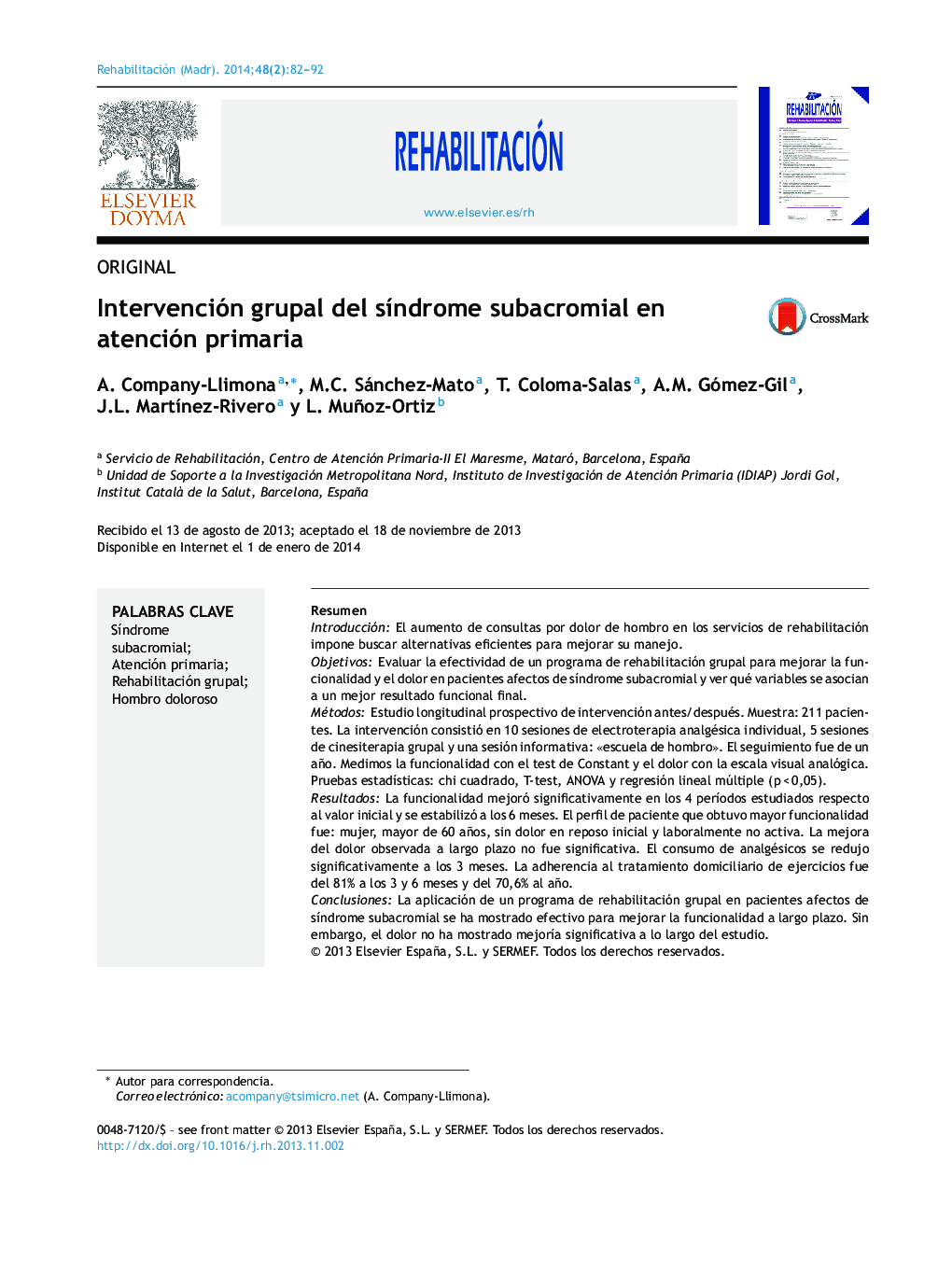| کد مقاله | کد نشریه | سال انتشار | مقاله انگلیسی | نسخه تمام متن |
|---|---|---|---|---|
| 4084923 | 1267818 | 2014 | 11 صفحه PDF | دانلود رایگان |
ResumenIntroducciónEl aumento de consultas por dolor de hombro en los servicios de rehabilitación impone buscar alternativas eficientes para mejorar su manejo.ObjetivosEvaluar la efectividad de un programa de rehabilitación grupal para mejorar la funcionalidad y el dolor en pacientes afectos de síndrome subacromial y ver qué variables se asocian a un mejor resultado funcional final.MétodosEstudio longitudinal prospectivo de intervención antes/después. Muestra: 211 pacientes. La intervención consistió en 10 sesiones de electroterapia analgésica individual, 5 sesiones de cinesiterapia grupal y una sesión informativa: «escuela de hombro». El seguimiento fue de un año. Medimos la funcionalidad con el test de Constant y el dolor con la escala visual analógica. Pruebas estadísticas: chi cuadrado, T-test, ANOVA y regresión lineal múltiple (p < 0,05).ResultadosLa funcionalidad mejoró significativamente en los 4 períodos estudiados respecto al valor inicial y se estabilizó a los 6 meses. El perfil de paciente que obtuvo mayor funcionalidad fue: mujer, mayor de 60 años, sin dolor en reposo inicial y laboralmente no activa. La mejora del dolor observada a largo plazo no fue significativa. El consumo de analgésicos se redujo significativamente a los 3 meses. La adherencia al tratamiento domiciliario de ejercicios fue del 81% a los 3 y 6 meses y del 70,6% al año.ConclusionesLa aplicación de un programa de rehabilitación grupal en pacientes afectos de síndrome subacromial se ha mostrado efectivo para mejorar la funcionalidad a largo plazo. Sin embargo, el dolor no ha mostrado mejoría significativa a lo largo del estudio.
IntroductionDue to the increase in consultations for shoulder pain in rehabilitation services, there is a need for efficient alternatives to improve the management of this disorder.ObjectivesTo evaluate the effectiveness of a supervised group exercise program to improve functionality and pain in patients with shoulder impingement syndrome and to identify the variables that are associated with a better functional outcome.MethodsA prospective longitudinal, pre and post intervention study was carried out in a sample of 211 patients. The treatment consisted of 10 individual sessions of analgesic electrotherapy, 5 sessions of group exercise therapy and an educational session: «shoulder school». One year follow-up was performed. Shoulder function and pain were assessed using Constant's test and the visual analogue scale. The statistical analysis was carried out with the chi-square test, T-test, ANOVA and multiple linear regression (P < .05).ResultsFunctionality improved significantly in all periods studied compared with baseline and stabilized at 6 months. The profile of patients who achieved greater functionality was female, older than 60 years, with no initial rest pain and occupationally inactive. Long-term pain improvement was not significant. Analgesic use was significantly reduced at 3 months. Adherence to home exercise treatment was 81% at 3 and 6 months and 70.6% at one year.ConclusionsThe application of a group rehabilitation program in patients with shoulder impingement syndrome was effective in improving long-term functionality. However, there was no significant pain improvement during the study.
Journal: Rehabilitación - Volume 48, Issue 2, April–June 2014, Pages 82–92
